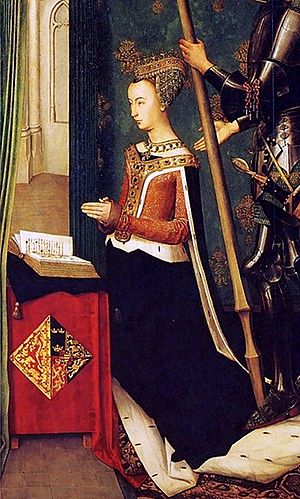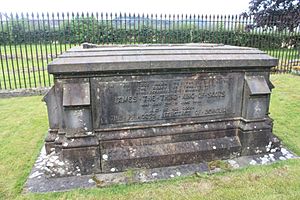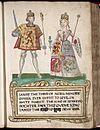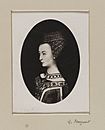Margaret of Denmark, Queen of Scotland facts for kids
Quick facts for kids Margaret of Denmark |
|
|---|---|

Margaret depicted in the Trinity Altarpiece by Hugo van der Goes, c. 1480
|
|
| Queen consort of Scotland | |
| Tenure | July 1469 – 14 July 1486 |
| Born | 23 June 1456 Copenhagen Castle, Copenhagen, Denmark |
| Died | 14 July 1486 (aged 30) Stirling Castle, Stirling, Scotland |
| Burial | Cambuskenneth Abbey |
| Spouse | |
| Issue | James IV of Scotland James, Duke of Ross John, Earl of Mar |
| House | Oldenburg |
| Father | Christian I of Denmark |
| Mother | Dorothea of Brandenburg |
| Religion | Roman Catholic |
Margaret of Denmark was born on June 23, 1456, in Copenhagen, Denmark. She became the Queen of Scotland in 1469 when she married King James III. Margaret was the daughter of King Christian I and Queen Dorothea of Denmark, Norway, and Sweden. She was Queen until her death on July 14, 1486.
Contents
Life as Queen of Scotland
Margaret grew up in Denmark. When she was only four years old, people started talking about her possibly marrying the Scottish Prince James. This marriage was a way to solve a big problem between Scotland and Denmark. Scotland owed Denmark money for taxes on the Hebrides and Isle of Man islands.
Marriage and New Lands
In 1468, Margaret became officially engaged to James of Scotland. This marriage was suggested by the King of France. In July 1469, when Margaret was 13, she married James III at Holyrood Abbey. When they married, Scotland's debt to Denmark was completely cancelled.
Because of this marriage, the Orkney Islands and Shetland Islands became part of Scotland. Before this, they were under Norse (Danish/Norwegian) rule. In 1472, the Scottish King took over the rights to these islands.
Life at Court
Queen Margaret received a large amount of money and property for her marriage. This included Linlithgow Palace and Doune Castle. She loved clothes and jewelry and was known for wearing the newest fashions.
After her son James was born in 1473, she went on a special trip to Whithorn Priory. She then joined the King at Falkland Palace. Some people believe she might have taught her son James to speak Danish. Margaret became a well-liked queen in Scotland. People described her as beautiful, kind, and smart.
Challenges and Family Life
Margaret's relationship with King James III was not always easy. One reason was that James seemed to prefer their second son over their oldest son. In 1476, King James wanted to give the Earldom of Ross to his second son. He accused the current Earl, John MacDonald, of treason. John MacDonald was put on trial. However, Queen Margaret asked for him to be allowed to stay as a Lord of Parliament, and her wish was granted.
In 1482, King James III temporarily lost his power. During this time, Margaret seemed more concerned about her children's safety than her husband's. This led to them growing apart. Politically, she worked to help her husband get his power back as king. After this event in 1482, the couple lived separately. James III stayed in Edinburgh, while Queen Margaret preferred to live at Stirling Castle with her children.
Death
Margaret passed away at Stirling Castle on July 14, 1486, after becoming ill. She was buried at Cambuskenneth Abbey. Her husband, James III, was buried next to her after he died in 1488.
Today, most of the abbey is in ruins, except for its bell-tower. In 1865, Queen Victoria, who was a descendant of Margaret, paid to have the grave restored.
There was a story, told by her son, that Margaret was killed by poison. The story claimed that John Ramsay, 1st Lord Bothwell, a political leader, gave her the poison. However, this is very unlikely. John Ramsay remained a favorite of the royal family even after Margaret's death. This suggests the story was probably just a rumor or untrue.
Queen Margaret's Style
Records show what clothes and fabrics were bought for Queen Margaret. Her servants bought materials and furs from merchants in Edinburgh. Shoemakers made her shoes, and a leather worker in Stirling made her gloves.
Fashion and Accessories
In 1473 and 1474, she had many garments made. These included:
- Gowns of blue velvet and red satin.
- Cloaks and a green damask kirtle (a type of dress).
- A riding gown.
- "Stomaks" (decorative front pieces for dresses) made of satin and lined with ermine fur.
- "Bonnets of tire" (hats) and "turrets" (veils).
- Tippets (shoulder coverings) and collars of velvet trimmed with fur.
Gowns were also bought for the six gentlewomen who attended her.
Jewelry and Treasures
After a battle in 1488, an inventory was made of a chest and a coffer (a strong box) at Stirling Castle. These contained some of Margaret's jewels.
- They included belts made of gold cloth and crimson fabric with gold decorations.
- There were rosaries and gold chains.
- One special item was a collar of chalcedony (a type of stone) with a pendant. This pendant held a container for musk perfume.
- She also had a pearl "fret" (a hair net) and a swan collar.
- A small bag held nine unset precious stones.
- Another bag contained lavender.
Some of her unique items included a "serpent tongue" and a piece of a unicorn horn set in gold. A "serpent tongue" was actually a fossilized shark's tooth. People at the time believed it could protect against poison. The unicorn horn was probably used to test food for poison during meals. She also owned a ring with a "paddock stone," which was a toadstone. This was also thought to be an antidote to poison.
Other treasures included a book of gold leaf for gilding (decorating with gold). She also had purple bed curtains and a counterpane (bedspread) embroidered with thistles and unicorns. She had a pendant shaped like her initial "M," set with diamonds and a large pearl.
Children
Margaret and James III had three sons:
- James IV (born March 17, 1473 – died September 9, 1513)
- James Stewart, Duke of Ross (born March 1476 – died January 1504)
- John Stewart, Earl of Mar (born December 1479 – died 1503)
Gallery
-
Stained Glass Window, Great Hall, Stirling Castle. The Great Hall was built by Queen Margaret's son King James IV.
-
Later depiction of Queen Margaret from a Jacobite broadside, based on the portrait by Hugo van der Goes.





